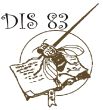
Garcia, R.N., L. Basso da Silva, and V.L.S. Valente. 2000. Banding techniques for Drosophila willistoni mitotic chromosomes. Dros. Inf. Serv. 83: 191-194.
|
|
|
|||
|
|
||||
Banding techniques
for Drosophila willistoni mitotic chromosomes.
Garcia, R.N.,
L. Basso da Silva, and V.L.S. Valente. Departamento
de Genética, Instituto de Biociências, Universidade Federal do
Rio Grande do Sul, Av. Bento Gonçalves 9500, Bloco B, Prédio
43323, Caixa Postal 15053. CEP 91501-970. Porto Alegre, RS, Brazil. * e-mail:
valente@if1.if.ufrgs.br
Studies on the heterochromatic regions of chromosomes have become more
and more interesting because it has been discovered that heterochromatin is
not "junk" DNA but an essential element of the eukaryotic genome,
with possible structural and/or functional relevance (Pardue and Henning,
1990; Henning, 1999). For example, changes in the heterochromatin could influence
the expression of genes by position‑effect variegation (PEV - reviewed
in Zhimulev, 1998). The chromosomes of Drosophila willistoni were first described by
Metz (1916) and later by Dobzhansky (1950) according to whom, this species
presents three pairs of mitotic chromosomes, one pair metacentric, one pair
acrocentric, and the metacentric sexual pair (X and Y). Chromosome pair II
is a little larger than the X- chromosome, while chromosome pair III is acrocentric.
In order to investigate the heterochromatic regions of D. willistoni metaphasic chromosomes,
we applied banding techniques based on the restriction endonucleases AluI and HaeIII as well as C‑banding
techniques. To our knowledge this is the first time that this combination
of techniques has been applied to these organisms.
The brain ganglia of Drosophila willistoni third instar larvae were processed according
to Imai et al. (1988). C‑ banding was carried out by the method
of Sumner (1972), except that incubation was in BaOH solution for 30 seconds.
After these procedures the slides were rinsed in distilled water, submitted
to incubation in double-strength 2´SSC solution for one hour,
rinsed again in distilled water and stained with 5% buffered Giemsa for 10
minutes. In order to induce banding by the restriction endonucleases AluI and HaeIII we applied the method
of Mezzanote (1986) using 10 or 20 units of each enzyme per slide. Before
submitting the slides to enzymatic digestion, the chromosomes were Giemsa
stained, photographed, and the stain removed by immersion in glacial acetic
acid for 10 minutes. The final staining of the slides was made with 4% Giemsa
(buffered at pH 6.8) for 10 minutes. Negative controls were made using identical
methods except that the restriction endonucleases were omitted.
The banding patterns obtained by AluI, HaeIII and C‑banding in the mitotic
chromosomes of D. willistoni were compared with the patterns induced by Giemsa staining (Figure 1).
Giemsa staining produced heavy bands in the centromeric and pericentromeric
regions of chromosome II and the X chromosome, as well as one band on the
centromere of chromosome III, and a stained block outside the centromeric
region. The Y chromosome appeared to be totally heterochromatic.
As far as could be seen by C-banding techniques the constitutive heterochromatin
in the chromosomes is localised in the centromeric regions of chromosome pairs
II and
III, and the X- chromosome. The Giemsa stained blocks in the pericentromeric
region of chromosomes II, III and X disappeared after C-banding, demonstrating
that they are not formed from constitutive heterochromatin. The Y chromosome,
that appeared totally heterochromatic with Giemsa staining, presented an intensely
stained band in the centromeric region after C-banding and was sub-metacentric
(Figure 2). This finding is different from that described by Dobzhansky (1950)
who classified the Y chromosome as metacentric.
 |
| Figure 1.
Mitotic chromosomes of third instar larvae brain ganglia of Drosophila
willistoni. 1A and 1B)
Giemsa stained. 2A and 2B) C- banded slides, with arrows indicating
the regions of constitutive heterochromatin, and the arms of Y chromosome
with different lenghts. 3)
Banding with AluI
in the same nucleus stained with Giemsa in Figure 1A. 4) Banding with HaeIII in the same nucleus stained with Giemsa in Figure 1B. Arrows indicate labels in the centromeric
and pericentromeric regions. Bar
= 10 mm. |
The restriction endonucleases did not attack the centromeric nor the
pericentromeric regions of the heterochromatin, and they did not modify the
Giemsa staining pattern (Figures 3 and 4). Strong digestion of the euchromatic
regions of the chromosomes, especially in chromosome III, was detected after
the enzyme treatments, but this did not provide any additional information
regarding differences in the constitutive heterochromatin of these regions.
We also tested higher concentrations of both enzymes (up to 22 units per slide),
but the results were the same as those obtained with 10 units per slide. The
packaging of the DNA of the mitotic chromosomes is so tight that it makes
enzyme penetration difficult (Dolfini, 1990). When compared with C-induced
banding, restriction enzyme banding did not reveal any new banding patterns
for the different classes of heterochromatin in the metaphase chromosomes
of D. willistoni. This has also been observed for D.
nasuta (Tiwari and Lakhotia, 1991),
in contrast to what happens in human and other mammalian chromosomes (Bianchi
et al., 1985).
Acknowledgments: The authors are grateful to CAPES,
CNPq and FAPERGS for fellowships and to CNPq, FAPERGS, FINEP and PROPESQ‑UFRGS
for research grants. We also thank MsC Marisa C. S. Colares, Dr. Margarete S. Mattevi,
Dr.
Julio Pieczarka, Dr. Thales R. Freitas, and Dr. Eliana Abdelhay for helpful
criticism, and Miss Nena B. Morales for technical assistance.
References: Bianchi, M.S., N.O. Bianchi, G.E. Pantelias,
and S. Wolff 1985, Chromosoma 91:131‑136; Dobzhansky, Th., 1950, J. Heredity 41:156‑158;
Dolfini, S.F., 1990, Hereditas 112:141‑149;
Henning, W., 1999, Chromosoma 108:1‑9, Imai, H T.; R.W. Taylor, M.W.J. Crosland, and R.H. Crozier
1988, Jpn. J. Genet. 63: 159‑185;
Metz, C. W., 1916, Am. Nat. 50: 587‑599; Mezzanotte, R., 1986; Chromosoma 93: 249-255; Pardue, M.L., and W. Henning 1990, Chromosoma
100:1‑7; Sumner, A.T.,
1972, Exp. Cell. Res. 75: 304‑306; Tiwari, P.K., and S.C. Lakhotia 1991, J. Biosci. 16:187‑197; Zhimulev, E.F., 1998, Polytene chromosomes,
heterochromatin and position effect variegation. In: Advances in Genetics.
(Hall, JC; T. Friedmann, J.C. Dunlap, and F. Giannelli, eds.), Academic
Press 37:1‑555.